January, 1998
Field Crops 28.5-18
Proceedings of the 1998 Forage Symposium
Corn Kernel Milk Stage And Silage Harvest Moisture
Joe Lauer, Agronomist
Any good forage crop should have high dry matter yield, high protein content, high
energy content (high digestibility), high intake potential (low fiber), and optimum
dry matter content at harvest for acceptable fermentation and storage. With the
exception of high protein level, corn silage exhibits these characteristics better
than other forages.
A number of management decisions are required to produce high yielding and high
quality corn silage. Beginning with the seed planted in the ground, hybrid selection
has been shown to account for significant differences in animal performance and
economic return. Other agronomic practices such as planting date, plant density,
row spacing, weed control, etc. all contribute to successful production of high
yielding, high quality corn silage. All will be for naught though unless corn is
harvested and ensiled at the proper whole plant moisture to ensure fermentation
for long-term storage.
The production difficulty farmers often encounter is timing harvest so that the
proper moisture for ensiling is obtained for the storage structure (Table 1). If
corn silage is too wet then yield is often reduced, silo seepage occurs and the
silage is sour tasting resulting in lower intake by livestock. If corn silage is
too dry then yield is often reduced, heat damage and mold more easily develops in
the silo because fermentation is inadequate, and the silage has lower protein, digestibility
and the vitamins A and E.
|
Table 1. Recommended silage moisture contents for various silo structures and suggested
kernel milk stage "triggers" to begin checking silage moisture.
|
Silo structure
|
Recommended moisture
content for ensiling
|
Kernel milk stage
"trigger"
|
|
|
%
|
%
|
|
Horizontal bunker silos
|
70 to 65
|
80
|
|
Bag silos
|
70 to 60
|
80
|
|
Upright concrete stave
|
65 to 60
|
60
|
|
Upright oxygen limiting
|
60 to 50
|
40
|
|
Silage moisture decreases at an average rate of 0.5% per day during September
|
Historically, up until the early 80's corn silage had always been harvested at Historically, up until the
early 80's corn silage had always been harvested at "black layer".
Wiersma et al. (1993) reported that whole plant moisture was predictable
using kernel milkline. They suggested that silage harvest should begin around 50%
kernel milk and be completed by 25% kernel milk. However, many farmers reported
silo seepage to occur when using this recommendation. Many modern corn hybrids released
since the research of Wiesrma et al. (1993), have the "stay-green" trait
where the kernels are mature (black layered), the ear turns brown and grain drydown
occurs even though the stover remains green. This trait maintains the integrity
of the plant longer into the fall improving combine-ability. Unfortunately the relationship
between whole plant silage moisture and kernel milk may no longer hold and may be
the reason farmers are observing increased silo seepage when using kernel milk.
Evidence to suggest that the relationship between whole plant silage moisture and
kernel milk may no longer hold is shown in Fig. 1. Each data point is the mean of
three replicates of a hybrid grown at a location (environment). The regression line
drawn through the data points fits nicely with the observations of Wiersma et al.
(1993), but the variability for any particular kernel milk stage is high. For example,
at the kernel milk stage of 50%, whole plant moisture varies from 50 to 74% whole
plant moisture. In most cases, corn hybrids would be either too wet or too dry at
50% kernel milk.
Figure 1.

The variability within the relationship between whole plant moisture and kernel
milk stage is usually observed regardless of production environment year (Fig. 2).
For the 1992 and 1997 production years, on average, the regression line through
the data points is typical of the relationship between whole plant moisture and
kernel milk stage described by other workers. But, wide whole plant moisture variability
exists for each kernel milk stage. Again, corn silage harvested at the 50% kernel
milk stage could be either too wet or too dry for a concrete stave silo.
Figure 2.
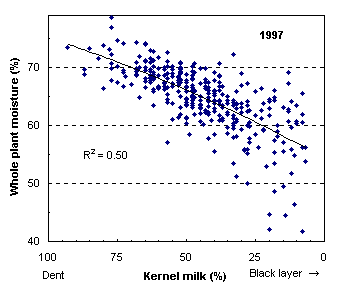
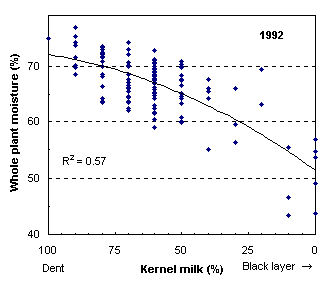
There is some thought that the relationship between whole plant moisture and kernel
milk stage may not vary as much for a particular hybrid. In our database, there
are some hybrids where the relationship is good, while the majority of the hybrids
show a poor relationship between whole plant moisture and kernel milk (Fig. 3 shows
a few examples). A total of 56 corn hybrids were evaluated where there had been
at least five environments of testing. Of these, only 10 hybrids had R2
values greater than 0.75. An example is Cargill 4327 which shows a good relationship
between whole plant moisture and kernel milk stage. Aproximately, 82% of the hybrids
exhibited a poor relationship between whole plant moisture and kernel milk stage.
Figure 3.
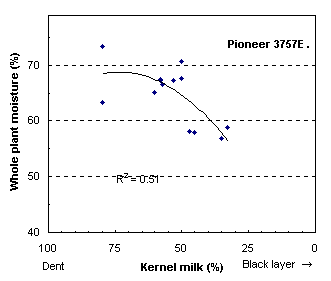
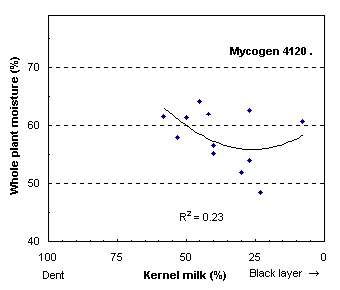
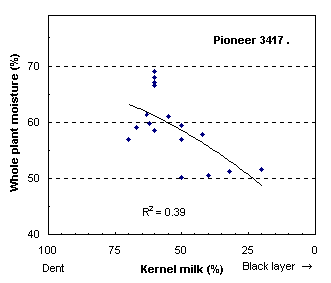

In conclusion, there appears to be no good, easily identifiable plant indicator
for accurately predicting whole plant moisture for ensiling corn. The only way to
truly measure the moisture of corn in a field is to measure by weighing it directly.
It is impracticle to characterize all corn hybrids as to the influence of the "stay-green"
trait because of the variability caused by environment and management.
But can we still use something like kernel milk stage as a plant indicator for predicting
whole plant moisture? I think we can if we think about it as a "trigger"
to go out and begin measuring the field for whole plant moisture. Generally the
amount of time it takes to go from dent to black layer is about 25 days (12 days
from dent to 50% kernel milk stage, and 13 days from 50% kernel milk stage to black
layer). Once we know where a field is at for whole plant moisture, we can use an
avaerage dry-down rate for the month of Septemeber of 0.5% drying per day. Hot dry
weather may speed up silage dryown, while cool, wet weather will slow it down.
The kernel milk "triggers" to begin moisture sampling fields are described
in Table 1 for various storage structures. Approximately 95% of the time the field
will be too wet for the storage structure when using the suggested triggers. But,
you will know where you are at with that field and by using the drydown rate of
0.5% per day, you can predict when to either test the field again or begin chopping
the field for ensiling.
Literature Cited
Wiersma, D.W., P.R. Carter, K.A. Albrecht, and J.G. Coors. 1993. Kernel milkline
stage and corn forage yield , quality and dry matter content. J. Prod. Agric.6:94-99.